Abstract
Background:
Community-based participatory research (CBPR) has been applied by health researchers and practitioners to address health disparities and community empowerment for health promotion. Despite the growing popularity of CBPR projects, there has been little effort to synthesize the literature to evaluate CBPR projects. The present review attempts to identify appropriate elements that may contribute to the successful or unsuccessful interventions.
Methods:
A systematic review was undertaken using evidence identified through searching electronic databases, web sites, and reference list checks. Predefined inclusion and exclusion criteria were assessed by reviewers. Levels of evidence, accounting for methodologic quality, were assessed for 3 types of CBPR approaches, including interventional, observational, and qualitative research design as well as CBPR elements through separate abstraction forms. Each included study was appraised with 2 quality grades, one for the elements of CBPR and one for research design.
Results:
Of 14,222 identified articles, 403 included in the abstract review. Of these, 70 CBPR studies, that 56 intervention studies had different designs, and finally 8 studies met the inclusion criteria. The findings show that collaboration among community partners, researchers, and organizations led to community-level action to improve the health and wellbeing and to minimize health disparities. It enhanced the capacity of the community in terms of research and leadership skills. The result provided examples of effective CBPR that took place in a variety of communities. However, little has been written about the organizational capacities required to make these efforts successful.
Conclusion:
Some evidences were found for potentially effective strategies to increase the participant's levels of CBPR activities. Interventions that included community involvement have the potential to make important differences to levels of activities and should be promoted.
Keywords: Community-based participatory research, effectiveness, researches, systematic review
INTRODUCTION
In order to reduce the challenges of community participation in health research methods, suggested solution is to use community-based participatory research (CBPR). This kind of research aims to promote health or decrease inequality in health by attracting community participation.[1]
It is reasonable to believe that CBPR can help partial improvement in health, education, and economy of the communities by promoting the quantity and quality of data because it is need oriented. This could happen due to the reliability, better formation of the subject, and direction of the research, which transfers knowledge to beneficiaries. The emphasis of CBPR is on its participative process, which empowers main partners.[2]
Based on review of the literature, CBPR approach could be implemented in descriptive research that attempts to identify social determinants of health.[3] It can also be a useful approach in research that seeks to explain disparities in health status or health-related risk factors.[4] Researches also used a CBPR approach with the purpose of better collaboration between research partners to identify needs, problems, and assets in special communities.[5,6] CBPR has the potential to make the positive community changes in efforts to design, implement, and evaluate intervention and policies.[7]
CBPR has had an upward movement, which increased opportunities of financial support from funding agencies. Thus, it is suggested that more attention should be granted to show positive effects of collaborative research approach.[8–10]
Successful CBPR projects that have been reported around the world demonstrate numerous strategies and techniques that they have used for developing and maintaining effective CBPR.[11–14]
Some studies believe that effectiveness of CBPR depends on the strength of effective communication and appreciating the culture of the community.[8,12] A previous review that assessed papers from 1961 to 2001 was designed and implemented in order to identify which CBPR researches should be supported by granting bodies, but it produced limited information on the effectiveness of CBPR.[8] In the present study, the aim was to pay more attention to the effectiveness aspects (positive changes in communities) of CBPR studies, especially to those studies in the time span after the previous review study.
METHODS
To identify published researches on CBPR, data sources, key words, and search strategies were defined. The PUBMED (MEDLINE), SCOPUS EMBASE, CINAHL, OVID MEDLIN, and Psy INFO databases were searched using the key phrases “Community-based participatory research” and “participatory action research.” Search strategy for PUBMED is shown in Table 1. Search strategy for each database was different according to specification of the databases. The main efforts were contributed to implement a systematic review on CBPR projects from 2000 to 2009. In addition, search has been done on the names of prominent authors in CBPR; manual search was conducted on all the reference lists.
Table 1.
Search strategy for Pubmed and used keywords
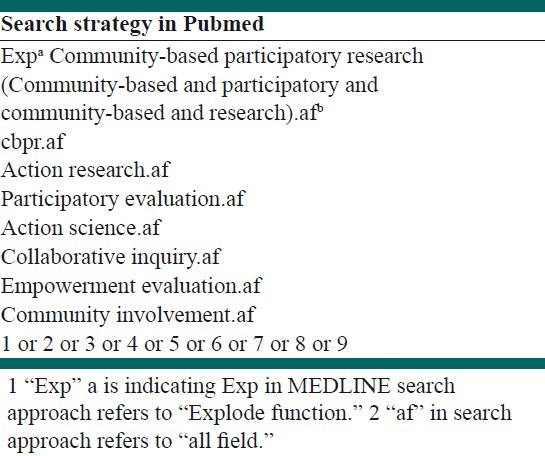
Inclusion criteria for papers were originality of the research and presence of CBPR elements participation in the process of execution of research, including choosing research question, proposal development: financial responsibility for grant funds, study design, building partnership, preparation of measurement instruments and data collection, development and implementation interventions, interpretation, and dissemination and applying the result. Studies that met at least 5 criteria were included.
In this review, the type of outcomes (such as diabetes, tuberculosis, and others) has not been considered as inclusion or exclusion criterion and any outcome relevant to community health has had the chance for entering the study. Due to large quantity of retrieved papers, a team of four acquainted persons in CBPR assessed the retrieved records. All papers related to a study were considered in the systematic review. The papers that were limited to descriptive processes of CBPR were excluded from this review.
In order to appraise the quality of papers, critical appraisal forms utilized in a previous review study[8] were used. These forms are divided into 2 main categories: one category was related to the quality of research methodology (which itself includes 3 forms of interventional, observational, and qualitative researches) and the others were related to the quality of participation and community engagement.[8]
Two persons independently were appraised the quality of papers and if there had been a disagreement between them, a third person would have taken the judgment. Finally, according to appraisal forms, each paper was taken a score: no or insufficient information (score 1), studies with medium or enough information (score 2 and score 3). These persons were not blinded to the names of authors and journals. Kappa statistics were used to assess the reliability of scores.
Figure 1 shows the process of selection and categorizing of enrolled studies. The following steps were taken according to this figure:
Figure 1.
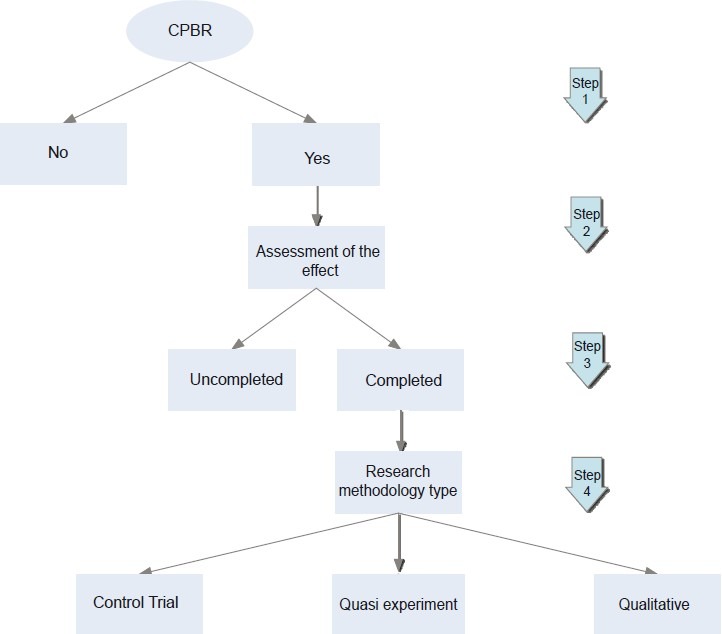
Process of selection and categorizing reviewed studies
First, papers were assessed according to main elements of CBPR. In case of presence of such elements, CBPR form was filled in. Then, papers were assessed based on whether they have evaluated interventions or not. Next, papers with intervention were divided into two: complete and incomplete categories. Finally, methodologic forms of intervention, quasi-experiment, or qualitative were filled in according to the results of the studies. In this article, we report the findings of completed controlled trials.
RESULTS
As shown in Figure 2, about 14,000 papers were in the primary list of the abstract review. At the end, 70 studies were chosen. Among them, 8 interventional studies were completed that met the inclusion criteria, 2 studies were incomplete interventional studies (in-progress studies), 23 studies were quasi-experiment, 23 qualitative studies, and 14 needed assessment with no intervention.
Figure 2.
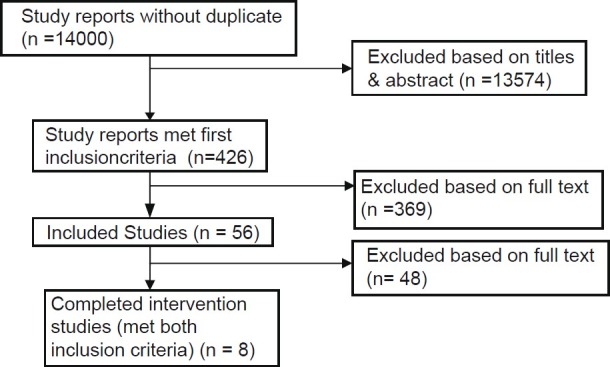
Process of selection and categorizing reviewed studies
The characteristics for effectiveness of intervention in completed interventional studies are summarized in Table 2. Integrating findings across the 8 studies demonstrated a set of effective interventions. In these studies, the effect of interventions on 7 studies reported statistically.
Table 2.
Evidences for effectiveness of completed intervened research
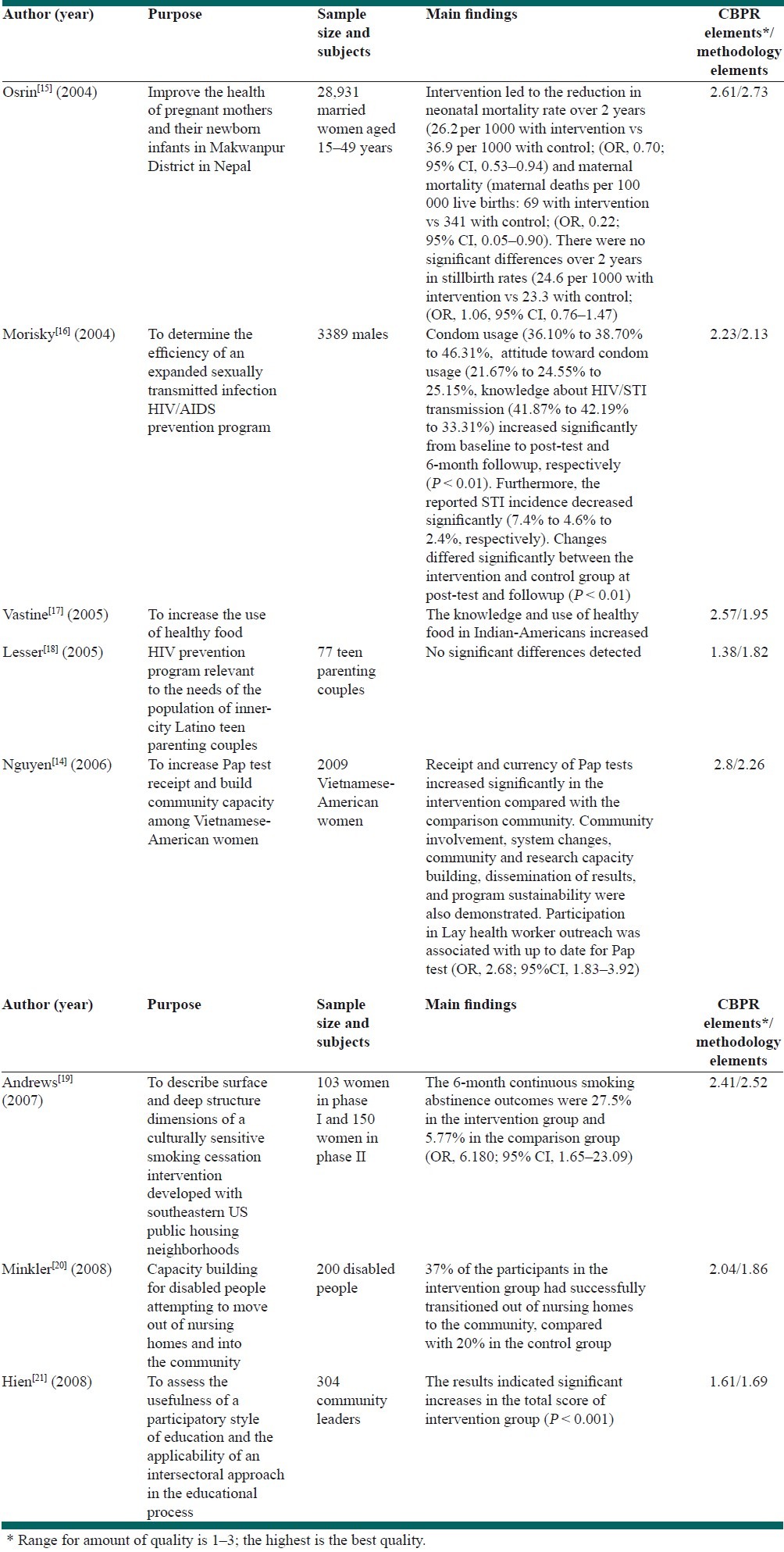
In the 8 completed interventional studies initiated by community-based organizations or university researchers, CBPR led to take action to improve the health and wellbeing of the community members, for example, to reduce maternal and neonatal mortality (Osrin et al.'s study[15]); to encourage condom usage that reduce sexually transmitted infectious diseases (Morisky et al.'s study[16]); to increase the use of healthy food (Vastine et al.'s study[17]); to force teen parenting couples for HIV prevention programs (Lesser et al.'s study[18]). In some studies, such as Nguyen's study[14] and Minkler study,[20] the intervention itself represented a significant action to improve community health, for example, in Nguyen's study, Vietnamese-American women not only became more knowledgeable about Pap test, but also it increased their ability to mobilize their community and help to build community capacity.
In 5 studies (Hien et al.,[21] Minkler, et al.,[20] Morisky, et al.,[16] Nguyen, et al.,[14] Osrin, et al.[15]) out of 8 complete reviewed intervention studies, community participatory-based research approach was introduced as an effective way toward promoting the health of community members.
Graph 1 illustrates the comparison in community participation percentage in different parts of research processes for the completed intervention studies.
Graph 1.
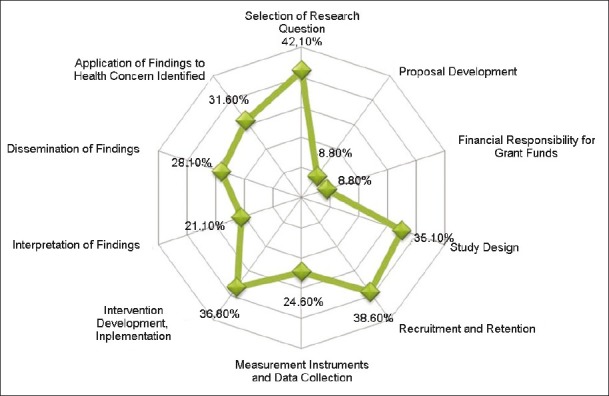
Comparison in community participation percentage in different parts of research processes for 8 completed intervention study
Community participation in different parts of a study among reviewed studies showed that selection of research question with 42.1% had greatest percentage and collaboration in preparing proposals and financial responsibility for grant funds with 8.8% had the lowest percentage among CBPR elements.
Research quality of the studies included in this review may not rate high with respect to research design rigor. Mean scores gained for qualities of research methodology and community participation in this review were 2.03 and 2.55, respectively.
DISCUSSION
To summarize the findings of current systematic review among the papers which were searched electronically, 70 papers were identified as CBPR papers. Out of them, 56 accomplished the criteria to enter principal assessment level, and they realized as important and practical aspects of CBPR research qualitative methodology. Out of 8 intervention studies using CBPR approach, 7 showed relative evidence of CBPR's effectiveness.
In a review of the CBPR literature related to health sponsored by the Agency for Health Care Research and Quality, Viswanathan and his colleagues found the evidences of enhanced research quality in completed intervention studies. This included evidences of enhanced participant recruitment, improved research methods, improved variable measurement, and improved intervention outcomes. They also came across limited evidence on reversed relationship between community participation and low-quality research.[8] In the present research, while paying attention to all significant elements of CBPR after conferring with experts due to importance and effectiveness, more consideration was paid to “research question selection,” “employing people in study,” “contribution in preparing measurement tools and data collection,” “development and intervention execution,” and “publishing the results.” Reporting these elements in the study was considered as criteria for empowerment.
Probably, this can show the reality that in addition to current problems in most common trials, researchers in CBPR cannot either provide the necessary balance between the main elements of CBPR and research methodology. Perhaps the presence of main participants (community members) who have little knowledge about research methodology is one of the reasons for weak or simple rate of study designs compared with the limited number of strong study designs.
Results showed that using strong research designs (e.g., randomized controlled trials) in community-based participatory researches are limited. In trial studies that were assessed in the present research, main problems were like the dose of other randomized controlled trials (it has been shown that the most trials are at least in one part inexpressive[15,22]).
The results also show that using research methodology for this approach even in community-based participatory researches using randomized controlled trial's design were not adequately used and taken into consideration, which highlights the necessity for paying attention to research methodology. The main point to be considered is that 8 complete trial studies, each assessing a different subject have entered our research, this diversity in using CBPR facilitates the use of different research designs, on the other hand it prevents generation of a pool measurement since measurements obtained from each study cannot be combined (meta-analysis is impractical).
The main limitations in this review were lack of review of unpublished articles or papers presented in confrances and also lack of contact with researchers. Despite related encouraging results in research regarding the efficiency of interventions in CBPR, there exist worries for lack of access to all relevant papers. This concern increased since we were not able to compare publication bias with other existing methods.
Keeping in mind the final purpose of CBPR, which is empowering the target community, outcomes of this review prove that the assessment of these types of research should not just be evaluated by health outcomes, and the point for consideration is “how much the target community has empowered.” It is worth mentioning that in the future research emphasis should be on evaluating the level of empowerment and stability of it in beneficiary community as criteria for CBPR's effectiveness.
CONCLUSION
We performed a systematic review to examine the effectiveness of current CBPR intervention studies to improve the health and wellbeing of communities in general and eliminate health disparities in particular. CBPR may be effective among intervention research methods if the researchers and communities well understand its principal value.
ACKNOWLEDGMENT
This paper is the result of a first author thesis for Master of Epidemiology in Tehran University of Medical Sciences (TUMS). The work has been supported by the School of Public Health at TUMS as well as Research Policy and Cooperation in Eastern Mediterranean Office of World Health Organization.
Footnotes
Source of Support: Nil
Conflict of Interest: None declared.
REFERENCES
- 1.Israel BA, Schulz AJ, Parker EA, Becker AB. Review of community-based research: Assessing partnership approaches to improve public health. Annu Rev Public Health. 1998;19:173–202. doi: 10.1146/annurev.publhealth.19.1.173. [DOI] [PubMed] [Google Scholar]
- 2.Israel BA, Krieger J, Vlahov D, Ciske S, Foley M, Fortin P, et al. Challenges and facilitating factors in sustaining community-based participatory research partnerships: lessons learned from the Detroit, New York City and Seattle Urban Research Centers. J Urban Health. 2006;83:1022–40. doi: 10.1007/s11524-006-9110-1. [DOI] [PMC free article] [PubMed] [Google Scholar]
- 3.Zenk S, Schulz AJ, House AB, Kannan S. Application of community-based participatory research in the design of an observational tool: The neighborhood observational checklist. In: Israel BA, Eng E, Schulz AJ, Parker E, editors. Methods in Community-Based Participatory Research for Health. San Francisco: Jossey-Bass; 2005. pp. 167–87. [Google Scholar]
- 4.Mullings L, Wali A, McLean D, Mitchell J, Prince S, Thomas D, et al. Qualitative methodologies and community participation in examining reproductive experiences: The Harlem Birth Right Project. Matern Child Health J. 2001;5:85–93. doi: 10.1023/a:1011397031640. [DOI] [PubMed] [Google Scholar]
- 5.Wing S. Social responsibility and research ethics in community-driven studies of industrialized hog production. Environ Health Perspect. 2002;110:437–44. doi: 10.1289/ehp.02110437. [DOI] [PMC free article] [PubMed] [Google Scholar]
- 6.Farquhar S, Wing S. Methodological and ethical considerations in community-driven environmental justice research: Two Case Studies from Rural North Carolina. In: Minkler M, Wallerstein N, editors. Community-Based Participatory Research for Health. San Francisco, Ca: Jossey-Bass; 2003. pp. 221–41. [Google Scholar]
- 7.Springett J. Issues in participatory evaluation. In: Minkler M, Wallerstein N, editors. Community-Based Participatory Research for Health. San Francisco, Ca: Jossey-Bass; 2003. pp. 263–88. [Google Scholar]
- 8.Viswanathan M, Ammerman A, Eng E, Gartlehner G, Lohr KN, Griffith D, et al. Community-based participatory research: Assessing the evidence (Structured abstract) Health Technology Assessment Database. 2004. [Last retrived on 2007 Mar 31]. Available from: http://www.ahrq.gov/downloads/pub/evidence/pdf/cbpr/cbpr.pdf . [PMC free article] [PubMed]
- 9.Minkler M. Community-based research partnerships: Challenges and opportunities. J Urban Health. 2005;82(2 Suppl 2):ii3–12. doi: 10.1093/jurban/jti034. [DOI] [PMC free article] [PubMed] [Google Scholar]
- 10.Majdzadeh R, Forouzan A, Pourmalek F, Malekafzali H. Community-Based Participatory Research: An approach to Deal with Social Determinants of Health. Iran J Public Health. 2009;38(Suppl 1):50–3. [Google Scholar]
- 11.Israel B. Methods in community-based participatory research for health. 1st ed. San Francisco: Jossey-Bass Inc Pub; 2005. [Google Scholar]
- 12.O’Fallon LR, Dearry A. Community-based participatory research as a tool to advance environmental health sciences. Environ Health Perspect. 2002;10(Suppl 2):155–9. doi: 10.1289/ehp.02110s2155. [DOI] [PMC free article] [PubMed] [Google Scholar]
- 13.Ali R, Olden K, Xu S. Community-based participatory research: A vehicle to promote public engagement for environmental health in China. Environ Health Perspect. 2008;116:1281–4. doi: 10.1289/ehp.11399. [DOI] [PMC free article] [PubMed] [Google Scholar]
- 14.Nguyen TT, McPhee SJ, Bui-Tong N, Luong TN, Ha-Iaconis T, Nguyen T, et al. Community-based participatory research increases cervical cancer screening among Vietnamese-Americans. J Health Care Poor Underserved. 2006;17(2 Suppl):31–54. doi: 10.1353/hpu.2006.0091. [DOI] [PubMed] [Google Scholar]
- 15.Osrin D, Manandhar D, Manandhar DS, Shrestha BP, Mesko N, Morrison J, et al. Members of the MIRA Makwanpur trial team., Effect of a participatory intervention with women's groups on birth outcomes in Nepal: Cluster-randomised controlled trial. Lancet. 2004;364:970–9. doi: 10.1016/S0140-6736(04)17021-9. [DOI] [PubMed] [Google Scholar]
- 16.Morisky DE, Ang A, Coly A, Tiglao TV. A model HIV/AIDS risk reduction program in the Philippines: A comprehensive community-based approach through participatory action research. Health Promot Int. 2004;19:69–76. doi: 10.1093/heapro/dah109. [DOI] [PubMed] [Google Scholar]
- 17.Vastine A, Gittelsohn J, Ethelbah B, Anliker J, Caballero B. Formative research and stakeholder participation in intervention development. Am J Health Behav. 2005;29:57–69. doi: 10.5993/ajhb.29.1.5. [DOI] [PubMed] [Google Scholar]
- 18.Lesser J, Verdugo RL, Koniak-Griffin D, Tello J, Kappos B, Cumberland WG. Respecting and protecting our relationships: A community research HIV prevention program for teen fathers and mothers. AIDS Educ Prev. 2005;17:347–60. doi: 10.1521/aeap.2005.17.4.347. [DOI] [PubMed] [Google Scholar]
- 19.Andrews JO, Bentley G, Crawford S, Pretlow L, Tingen MS. Using community-based participatory research to develop a culturally sensitive smoking cessation intervention with public housing neighborhoods. Ethn Dis. 2007;17:331–7. [PubMed] [Google Scholar]
- 20.Minkler M, Hammel J, Gill CJ, Magasi S, Vasquez VB. Community-Based Participatory Research in Disability and Long-Term Care Policy. A Case Study. J Disabil Policy Stud. 2008;19:114–26. [Google Scholar]
- 21.Hien Le TT, Takano T, Seino K, Ohnishi M, Nakamura K. Effectiveness of a capacity-building program for community leaders in a healthy living environment: A randomized community-based intervention in rural Vietnam. Health Promot Int. 2008;23:354–64. doi: 10.1093/heapro/dan035. [DOI] [PubMed] [Google Scholar]
- 22.Sanson-Fisher RW, Bonevski B, Green LW, D’Este C. Limitations of the randomized controlled trial in evaluating population-based health interventions. Am J Prev Med. 2007;33:155–61. doi: 10.1016/j.amepre.2007.04.007. [DOI] [PubMed] [Google Scholar]


